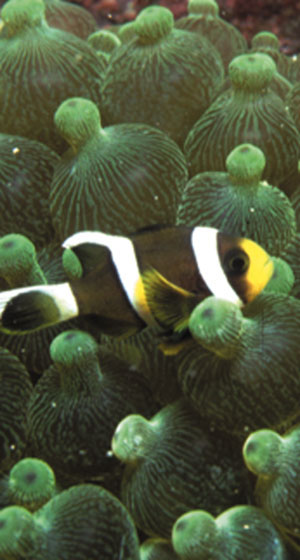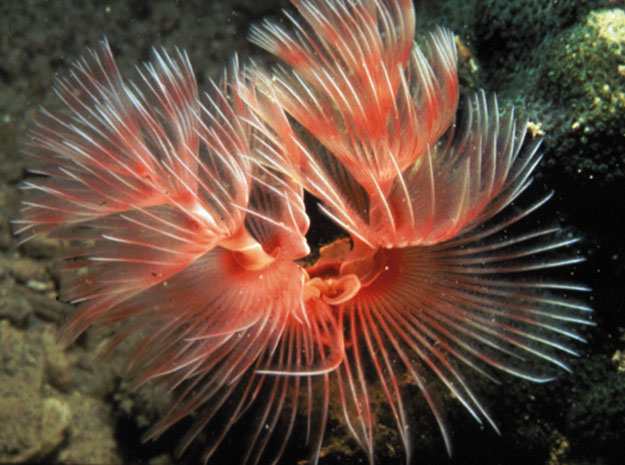Three marine conservation areas are opened
By Helena Chui
Human beings' destruction of the aquatic environment has driven green groups to seek protection for the precious remaining resources. Building marine conservation areas is one method of doing this.
Mr. Alexander Yan Wing Lok, chief secretary of Green Power, said, "Marine protection is a feature of modern civilization, but Hong Kong is 20 years behind in this area."
 Hong Kong's first three marine conservation areas opened in September. They are Hoi Ha Wan and Yan Chau Tong marine parks in Sai Kung, and the Cape D'Aguilar Marine Reserve at the southeast part of Hong Kong Island.
Hong Kong's first three marine conservation areas opened in September. They are Hoi Ha Wan and Yan Chau Tong marine parks in Sai Kung, and the Cape D'Aguilar Marine Reserve at the southeast part of Hong Kong Island.
Said Prof. Brian Morton of the Department of Ecology and Biodiversity at the University of Hong Kong: "Just like country parks, marine conservation areas tend to preserve some beautiful and interesting place."
Each one has its own significance. Hoi Ha Wan is a sheltered bay with a rich coral community on its flanks. Most of the local stony corals and some rare marine organisms can be found there. Lai Chi Wo, a part of Yau Chau Tong, was designated a site of special scientific interest in 1979 because a temperate species of marine eel grass called Zostera japonicus grows there.
In Cape d'Aguilar, a wide variety of rocks creates an unusual coastline. New communities of intertidal animals are found there.
In the reserves, fishing and pleasure boating are prohibited because they are used for education and scientific research. But they eventually will be open to the public in organized trips.
Prof. Morton said, "We are going to build in Cape d'Aguilar Marine Reserve an education centre in which groups of the public and schools can visit, so they can learn about Hong Kong's marine life."
Activities in the marine parks are less restricted. People can go sailing, rowing, canoeing and swimming. People can even collect marine animals if they have permits from the Agriculture and Fisheries Department.
In Hoi Ha Wan, the World Wide Fund for Nature Hong Kong is building an education centre. People can go boating on a glass bottomed boat and see samples of marine life.
Mr. Yan of Green Power said, "The management concept of the marine conservation areas in Hong Kong is different from that of other countries.
"In other countries such as Taiwan, such areas are mainly for education. In Hong Kong, they also serve recreational purposes. It is more difficult to manage the areas."
 Fishing can be benefit from the opening of marine conservation areas.
Fishing can be benefit from the opening of marine conservation areas.
Prof. Morton said, "You see in other parts in the world, like New Zealand and the Philippines, fishermen who first opposed marine parks and reserves, changing their attitude in four or five years. As the areas offer safe breeding grounds for fishes, the fishermen can get more fish in the surrounding water. Eventually, the fishermen want their governments to set up more parks and reserves."
However, pollution may be a threat. Mr. Edward Wong Cheuk-kee, the senior marine parks officer at the Agriculture and Fisheries Department, said, "The water quality in the marine conservation areas remains good, and no large water disposal occurs nearby.
"The government's approach to water treatment is actually no treatment, but disposal," he added.
Prof. Morton said that the success of the marine conservation areas depends upon Hong Kong people's ability to control pollution.
"At Hoi Ha and Yau Chau Tong, the water has already been polluted from that of Tolo Harbour," he said.
According to Prof. Morton, the Territory's coastline from Castle Peak, Tuen Mun, to Tsuen Wan and Lantau, have mostly been destroyed. Therefore, the marine conservation areas with rich marine life are precious in Hong Kong.
Said Prof. Morton: "It has taken a long time to develop the conservation areas.
"We should see if we can control destructive activities so that anybody can have benefit. If it is successful, maybe we can have more," he added.

